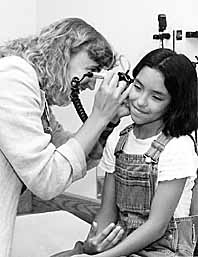

"Teachers learned a lot," says science coordinator Sherry Schaaf of the Quillayute Valley district, "and they really have been implementing it. If you're going to make a big change in your curriculum, you have to do this for your teachers."
The UW's K-12 Institute coordinates more than 30 UW programs designed with and for school districts around the state. Such programs

"Everyone knows about the UW Medical Center and Harborview in Seattle," says Dr. Foote. "Not so many people realize all the UW does across the state."
 Seattle-area traffic congestion ranks among the ten worst in the nation.
Building new highways is one expensive option. Making more efficient use
of the roads and transportation systems we already have is less costly and
quicker. This is the approach behind Intelligent Transportation Systems, a
program of the UW College of Engineering. "Intelligent"
solutions may one day include fully automated highways; meanwhile, the UW
team experiments with near-term improvements.
Seattle-area traffic congestion ranks among the ten worst in the nation.
Building new highways is one expensive option. Making more efficient use
of the roads and transportation systems we already have is less costly and
quicker. This is the approach behind Intelligent Transportation Systems, a
program of the UW College of Engineering. "Intelligent"
solutions may one day include fully automated highways; meanwhile, the UW
team experiments with near-term improvements.
One such improvement, new last June, is Traffic TV: live video images of traffic snarls around Puget Sound, along with current travel speeds on area highways, broadcast real-time over cable TV. It is the only such broadcast in the country and uses data-dissemination technology pioneered at the UW. A collaboration with the state Department of Transportation, Traffic TV is meant to help people dodge problems, cut their own rush-hour commutes, and reduce general congestion.
Traffic TV is part of an $18-million, four-city initiative of the U.S. Department of Transportation called Smart Trek. UW electrical engineering professor Dan Dailey, an expert in transportation technology, is the project leader for Seattle. In addition to Traffic TV, he and his team have developed two new real-time information programs for bus-riders, Bus View and Transit Watch. "What Smart Trek is all about," says Dailey, "is using technology to provide information that helps people make better travel decisions and reduce stress."
 Puget Sound is a beautiful, complex, and threatened ecosystem. Human
inhabitants enjoy, use, damage, and try to protect its forests, rivers,
fish, and the Sound itself. The latest alarm bell is a notice from the
federal government that it will likely add Puget Sound Chinook salmon runs
to its list of endangered species.
Puget Sound is a beautiful, complex, and threatened ecosystem. Human
inhabitants enjoy, use, damage, and try to protect its forests, rivers,
fish, and the Sound itself. The latest alarm bell is a notice from the
federal government that it will likely add Puget Sound Chinook salmon runs
to its list of endangered species.
One challenge, as governments and citizens work to preserve the Puget Sound environment, is the sheer number of human and natural systems that interact here. "A lot of smart people have worked hard to assemble information on key pieces of the Puget Sound ecosystem," says UW oceanography professor Jeff Richey, "but no one agency or organization has been able to pull the data into a cohesive whole."
This is the ambitious goal of a new UW program called PRISM--Puget Sound Regional Synthesis Model. Richey heads the program, one of the first projects supported by the new University Initiatives Fund. In the effort to gather and integrate a vast range of data, PRISM will draw on interdisciplinary research strengths across the campus, from urban planning to forest resources, and will also work with community partners.
A key part of the project will be its "virtual Puget Sound": a powerful computer model in which all the data interact. This model will let researchers and policy makers "see," for example, how new land use policies in one part of the Sound ecosystem would affect water quality in another. As a tool--both precise and comprehensive--for making these kinds of calculations and decisions, PRISM will help shape the future of the Sound.